Modern classification
Minerals are classified by variety, species, series and group, in order of increasing generality. The basic level of definition is that of mineral species, each of which is distinguished from the others by unique chemical and physical properties. For example, quartz is defined by its formula, SiO2, and a specific crystalline structure that distinguishes it from other minerals with the same chemical formula (termed polymorphs). When there exists a range of composition between two minerals species, a mineral series is defined. For example, the biotite series is represented by variable amounts of the endmembers phlogopite, siderophyllite, annite, and eastonite. In contrast, a mineral group is a grouping of mineral species with some common chemical properties that share a crystal structure. The pyroxene group has a common formula of XY(Si,Al)2O6, where X and Y are both cations, with X typically bigger than Y; the pyroxenes are single-chain silicates that crystallize in either the orthorhombic or monoclinic crystal systems. Finally, a mineral variety is a specific type of mineral species that differs by some physical characteristic, such as colour or crystal habit. An example is amethyst, which is a purple variety of quartz.[16]
Two common classifications, Dana and Strunz, are used for minerals; both rely on composition, specifically with regards to important chemical groups, and structure. James Dwight Dana, a leading geologist of his time, first published his System of Mineralogy in 1837; as of 1997, it is in its eighth edition. The Dana classification assigns a four-part number to a mineral species. Its class number is based on important compositional groups; the type gives the ratio of cations to anions in the mineral, and the last two numbers group minerals by structural similarity within a given type or class. The less commonly used Strunz classification, named for German mineralogist Karl Hugo Strunz, is based on the Dana system, but combines both chemical and structural criteria, the latter with regards to distribution of chemical bonds.[96]
As the composition of the Earth's crust is dominated by silicon
and oxygen, silicates are by far the most important class of minerals in
terms of rock formation and diversity. However, non-silicate minerals
are of great economic importance, especially as ores.[97][98]
Non-silicate minerals are subdivided into several other classes by
their dominant chemistry, which includes native elements, sulfides,
halides, oxides and hydroxides, carbonates and nitrates, borates,
sulfates, phosphates, and organic compounds. Most non-silicate mineral
species are rare (constituting in total 8% of the Earth's crust),
although some are relatively common, such as calcite, pyrite, magnetite, and hematite. There are two major structural styles observed in non-silicates: close-packing and silicate-like linked tetrahedra. Close-packed structures
are a way to densely pack atoms while minimizing interstitial space.
Hexagonal close-packing involves stacking layers where every other layer
is the same ("ababab"), whereas cubic close-packing involves stacking
groups of three layers ("abcabcabc"). Analogues to linked silica
tetrahedra include SO4−
4 (sulfate), PO4−
4 (phosphate), AsO4−
4 (arsenate), and VO4−
4 (vanadate) structures. The non-silicates have great economic importance, as they concentrate elements more than the silicate minerals do.[99]
The largest grouping of minerals by far are the silicates; most rocks are composed of greater than 95% silicate minerals, and over 90% of the Earth's crust is composed of these minerals.[100] The two main constituents of silicates are silicon and oxygen, which are the two most abundant elements in the Earth's crust. Other common elements in silicate minerals correspond to other common elements in the Earth's crust, such as aluminium, magnesium, iron, calcium, sodium, and potassium.[101] Some important rock-forming silicates include the feldspars, quartz, olivines, pyroxenes, amphiboles, garnets, and micas.
Silicates
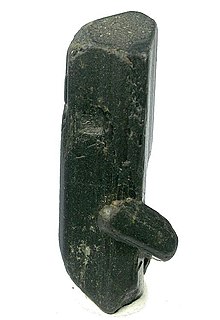
The base unit of a silicate mineral is the [SiO4]4− tetrahedron. In the vast majority of cases, silicon is in four-fold or tetrahedral coordination with oxygen. In very high-pressure situations, silicon will be in six-fold or octahedral coordination, such as in the perovskite structure or the quartz polymorph stishovite (SiO2). In the latter case, the mineral no longer has a silicate structure, but that of rutile (TiO2), and its associated group, which are simple oxides. These silica tetrahedra are then polymerized to some degree to create various structures, such as one-dimensional chains, two-dimensional sheets, and three-dimensional frameworks. The basic silicate mineral where no polymerization of the tetrahedra has occurred requires other elements to balance out the base 4- charge. In other silicate structures, different combinations of elements are required to balance out the resultant negative charge. It is common for the Si4+ to be substituted by Al3+ because of similarity in ionic radius and charge; in those cases, the [AlO4]5− tetrahedra form the same structures as do the unsubstituted tetrahedra, but their charge-balancing requirements are different.[102]
The degree of polymerization can be described by both the structure formed and how many tetrahedral corners (or coordinating oxygens) are shared (for aluminium and silicon in tetrahedral sites):[103][104]
- Orthosilicates (or nesosilicates)
- Have no linking of polyhedra, thus tetrahedra share no corners.
- Disilicates (or sorosilicates)
- Have two tetrahedra sharing one oxygen atom.
- Inosilicates are chain silicates
- Single-chain silicates have two shared corners, whereas double-chain silicates have two or three shared corners.
- Phyllosilicates
- Have a sheet structure which requires three shared oxygens; in the case of double-chain silicates, some tetrahedra must share two corners instead of three as otherwise a sheet structure would result.
- Framework silicates (or tectosilicates)
- Have tetrahedra that share all four corners.
- Ring silicates (or cyclosilicates)
- Only need tetrahedra to share two corners to form the cyclical structure.[104]
The silicate subclasses are described below in order of decreasing polymerization.
Tectosilicates
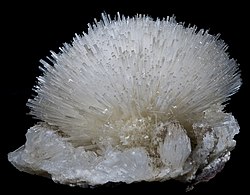
Tectosilicates, also known as framework silicates, have the highest degree of polymerization. With all corners of a tetrahedra shared, the silicon:oxygen ratio becomes 1:2. Examples are quartz, the feldspars, feldspathoids, and the zeolites. Framework silicates tend to be particularly chemically stable as a result of strong covalent bonds.[105]
Forming 12% of the Earth's crust, quartz (SiO2) is the most abundant mineral species. It is characterized by its high chemical and physical resistivity. Quartz has several polymorphs, including tridymite and cristobalite at high temperatures, high-pressure coesite, and ultra-high pressure stishovite. The latter mineral can only be formed on Earth by meteorite impacts, and its structure has been compressed so much that it has changed from a silicate structure to that of rutile (TiO2). The silica polymorph that is most stable at the Earth's surface is α-quartz. Its counterpart, β-quartz, is present only at high temperatures and pressures (changes to α-quartz below 573 °C at 1 bar). These two polymorphs differ by a "kinking" of bonds; this change in structure gives β-quartz greater symmetry than α-quartz, and they are thus also called high quartz (β) and low quartz (α).[100][106]
Feldspars are the most abundant group in the Earth's crust, at about 50%. In the feldspars, Al3+ substitutes for Si4+, which creates a charge imbalance that must be accounted for by the addition of cations. The base structure becomes either [AlSi3O8]− or [Al2Si2O8]2− There are 22 mineral species of feldspars, subdivided into two major subgroups – alkali and plagioclase – and two less common groups – celsian and banalsite. The alkali feldspars are most commonly in a series between potassium-rich orthoclase and sodium-rich albite; in the case of plagioclase, the most common series ranges from albite to calcium-rich anorthite. Crystal twinning is common in feldspars, especially polysynthetic twins in plagioclase and Carlsbad twins in alkali feldspars. If the latter subgroup cools slowly from a melt, it forms exsolution lamellae because the two components – orthoclase and albite – are unstable in solid solution. Exsolution can be on a scale from microscopic to readily observable in hand-sample; perthitic texture forms when Na-rich feldspar exsolve in a K-rich host. The opposite texture (antiperthitic), where K-rich feldspar exsolves in a Na-rich host, is very rare.[107]
Feldspathoids are structurally similar to feldspar, but differ in that they form in Si-deficient conditions, which allows for further substitution by Al3+. As a result, feldspathoids are almost never found in association with quartz. A common example of a feldspathoid is nepheline ((Na, K)AlSiO4); compared to alkali feldspar, nepheline has an Al2O3:SiO2 ratio of 1:2, as opposed to 1:6 in alkali feldspar.[108] Zeolites often have distinctive crystal habits, occurring in needles, plates, or blocky masses. They form in the presence of water at low temperatures and pressures, and have channels and voids in their structure. Zeolites have several industrial applications, especially in waste water treatment.[109]
Phyllosilicates
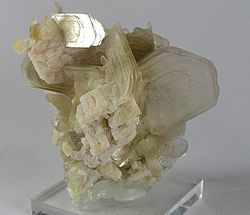
Phyllosilicates consist of sheets of polymerized tetrahedra. They are bound at three oxygen sites, which gives a characteristic silicon:oxygen ratio of 2:5. Important examples include the mica, chlorite, and the kaolinite-serpentine groups. In addition to the tetrahedra, phyllosilicates have a sheet of octahedra (elements in six-fold coordination by oxygen) that balance out the basic tetrahedra, which have a negative charge (e.g. [Si4O10]4−) These tetrahedra (T) and octahedra (O) sheets are stacked in a variety of combinations to create phyllosilicate layers. Within an octahedral sheet, there are three octahedral sites in a unit structure; however, not all of the sites may be occupied. In that case, the mineral is termed dioctahedral, whereas in other case it is termed trioctahedral.[110] The layers are weakly bound by van der Waals forces, hydrogen bonds, or sparse ionic bonds, which causes a crystallographic weakness, in turn leading to a prominent basal cleavage among the phyllosilicates.[111]
The kaolinite-serpentine group consists of T-O stacks (the 1:1 clay minerals); their hardness ranges from 2 to 4, as the sheets are held by hydrogen bonds. The 2:1 clay minerals (pyrophyllite-talc) consist of T-O-T stacks, but they are softer (hardness from 1 to 2), as they are instead held together by van der Waals forces. These two groups of minerals are subgrouped by octahedral occupation; specifically, kaolinite and pyrophyllite are dioctahedral whereas serpentine and talc trioctahedral.[112]
Micas are also T-O-T-stacked phyllosilicates, but differ from the other T-O-T and T-O-stacked subclass members in that they incorporate aluminium into the tetrahedral sheets (clay minerals have Al3+ in octahedral sites). Common examples of micas are muscovite, and the biotite series. Mica T-O-T layers are bonded together by metal ions, giving them a greater hardness than other phyllosilicate minerals, though they retain perfect basal cleavage.[113] The chlorite group is related to mica group, but a brucite-like (Mg(OH)2) layer between the T-O-T stacks.[114]
Because of their chemical structure, phyllosilicates typically have flexible, elastic, transparent layers that are electrical insulators and can be split into very thin flakes. Micas can be used in electronics as insulators, in construction, as optical filler, or even cosmetics. Chrysotile, a species of serpentine, is the most common mineral species in industrial asbestos, as it is less dangerous in terms of health than the amphibole asbestos.[115]
Inosilicates
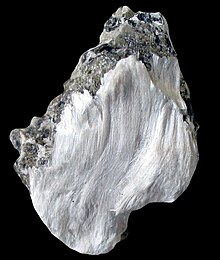
Inosilicates consist of tetrahedra repeatedly bonded in chains. These chains can be single, where a tetrahedron is bound to two others to form a continuous chain; alternatively, two chains can be merged to create double-chain silicates. Single-chain silicates have a silicon:oxygen ratio of 1:3 (e.g. [Si2O6]4−), whereas the double-chain variety has a ratio of 4:11, e.g. [Si8O22]12−. Inosilicates contain two important rock-forming mineral groups; single-chain silicates are most commonly pyroxenes, while double-chain silicates are often amphiboles.[116] Higher-order chains exist (e.g. three-member, four-member, five-member chains, etc.) but they are rare.[117]
The pyroxene group consists of 21 mineral species.[118] Pyroxenes have a general structure formula of XY(Si2O6), where X is an octahedral site, while Y can vary in coordination number from six to eight. Most varieties of pyroxene consist of permutations of Ca2+, Fe2+ and Mg2+ to balance the negative charge on the backbone. Pyroxenes are common in the Earth's crust (about 10%) and are a key constituent of mafic igneous rocks.[119]
Amphiboles have great variability in chemistry, described variously as a "mineralogical garbage can" or a "mineralogical shark swimming a sea of elements". The backbone of the amphiboles is the [Si8O22]12−; it is balanced by cations in three possible positions, although the third position is not always used, and one element can occupy both remaining ones. Finally, the amphiboles are usually hydrated, that is, they have a hydroxyl group ([OH]−), although it can be replaced by a fluoride, a chloride, or an oxide ion.[120] Because of the variable chemistry, there are over 80 species of amphibole, although variations, as in the pyroxenes, most commonly involve mixtures of Ca2+, Fe2+ and Mg2+.[118] Several amphibole mineral species can have an asbestiform crystal habit. These asbestos minerals form long, thin, flexible, and strong fibres, which are electrical insulators, chemically inert and heat-resistant; as such, they have several applications, especially in construction materials. However, asbestos are known carcinogens, and cause various other illnesses, such as asbestosis; amphibole asbestos (anthophyllite, tremolite, actinolite, grunerite, and riebeckite) are considered more dangerous than chrysotile serpentine asbestos.[121]
Cyclosilicates

Cyclosilicates, or ring silicates, have a ratio of silicon to oxygen of 1:3. Six-member rings are most common, with a base structure of [Si6O18]12−; examples include the tourmaline group and beryl. Other ring structures exist, with 3, 4, 8, 9, 12 having been described.[122] Cyclosilicates tend to be strong, with elongated, striated crystals.[123]
Tourmalines have a very complex chemistry that can be described by a general formula XY3Z6(BO3)3T6O18V3W. The T6O18 is the basic ring structure, where T is usually Si4+, but substitutable by Al3+ or B3+. Tourmalines can be subgrouped by the occupancy of the X site, and from there further subdivided by the chemistry of the W site. The Y and Z sites can accommodate a variety of cations, especially various transition metals; this variability in structural transition metal content gives the tourmaline group greater variability in colour. Other cyclosilicates include beryl, Al2Be3Si6O18, whose varieties include the gemstones emerald (green) and aquamarine (bluish). Cordierite is structurally similar to beryl, and is a common metamorphic mineral.[124]
Sorosilicates

Sorosilicates, also termed disilicates, have tetrahedron-tetrahedron bonding at one oxygen, which results in a 2:7 ratio of silicon to oxygen. The resultant common structural element is the [Si2O7]6− group. The most common disilicates by far are members of the epidote group. Epidotes are found in variety of geologic settings, ranging from mid-ocean ridge to granites to metapelites. Epidotes are built around the structure [(SiO4)(Si2O7)]10− structure; for example, the mineral species epidote has calcium, aluminium, and ferric iron to charge balance: Ca2Al2(Fe3+, Al)(SiO4)(Si2O7)O(OH). The presence of iron as Fe3+ and Fe2+ helps buffer oxygen fugacity, which in turn is a significant factor in petrogenesis.[125]
Other examples of sorosilicates include lawsonite, a metamorphic mineral forming in the blueschist facies (subduction zone setting with low temperature and high pressure), vesuvianite, which takes up a significant amount of calcium in its chemical structure.[125][126]
Orthosilicates

Orthosilicates consist of isolated tetrahedra that are charge-balanced by other cations.[127] Also termed nesosilicates, this type of silicate has a silicon:oxygen ratio of 1:4 (e.g. SiO4). Typical orthosilicates tend to form blocky equant crystals, and are fairly hard.[128] Several rock-forming minerals are part of this subclass, such as the aluminosilicates, the olivine group, and the garnet group.
The aluminosilicates –bkyanite, andalusite, and sillimanite, all Al2SiO5 – are structurally composed of one [SiO4]4− tetrahedron, and one Al3+ in octahedral coordination. The remaining Al3+ can be in six-fold coordination (kyanite), five-fold (andalusite) or four-fold (sillimanite); which mineral forms in a given environment is depend on pressure and temperature conditions. In the olivine structure, the main olivine series of (Mg, Fe)2SiO4 consist of magnesium-rich forsterite and iron-rich fayalite. Both iron and magnesium are in octahedral by oxygen. Other mineral species having this structure exist, such as tephroite, Mn2SiO4.[129] The garnet group has a general formula of X3Y2(SiO4)3, where X is a large eight-fold coordinated cation, and Y is a smaller six-fold coordinated cation. There are six ideal endmembers of garnet, split into two group. The pyralspite garnets have Al3+ in the Y position: pyrope (Mg3Al2(SiO4)3), almandine (Fe3Al2(SiO4)3), and spessartine (Mn3Al2(SiO4)3). The ugrandite garnets have Ca2+ in the X position: uvarovite (Ca3Cr2(SiO4)3), grossular (Ca3Al2(SiO4)3) and andradite (Ca3Fe2(SiO4)3). While there are two subgroups of garnet, solid solutions exist between all six end-members.[127]
Other orthosilicates include zircon, staurolite, and topaz. Zircon (ZrSiO4) is useful in geochronology as U6+ can substitute for Zr4+; furthermore, because of its very resistant structure, it is difficult to reset it as a chronometer. Staurolite is a common metamorphic intermediate-grade index mineral. It has a particularly complicated crystal structure that was only fully described in 1986. Topaz (Al2SiO4(F, OH)2, often found in granitic pegmatites associated with tourmaline, is a common gemstone mineral.[130]
Non-silicates
Native elements
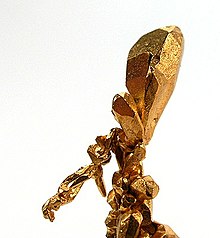
Native elements are those that are not chemically bonded to other elements. This mineral group includes native metals, semi-metals, and non-metals, and various alloys and solid solutions. The metals are held together by metallic bonding, which confers distinctive physical properties such as their shiny metallic lustre, ductility and malleability, and electrical conductivity. Native elements are subdivided into groups by their structure or chemical attributes.
The gold group, with a cubic close-packed structure, includes metals such as gold, silver, and copper. The platinum group is similar in structure to the gold group. The iron-nickel group is characterized by several iron-nickel alloy species. Two examples are kamacite and taenite, which are found in iron meteorites; these species differ by the amount of Ni in the alloy; kamacite has less than 5–7% nickel and is a variety of native iron, whereas the nickel content of taenite ranges from 7–37%. Arsenic group minerals consist of semi-metals, which have only some metallic traits; for example, they lack the malleability of metals. Native carbon occurs in two allotropes, graphite and diamond; the latter forms at very high pressure in the mantle, which gives it a much stronger structure than graphite.[131]
Sulfides
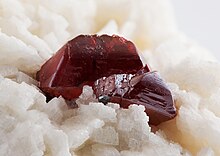

The sulfide minerals are chemical compounds of one or more metals or semimetals with a chalcogen or pnictogen, of which sulfur is most common. Tellurium, arsenic, or selenium can substitute for the sulfur. Sulfides tend to be soft, brittle minerals with a high specific gravity. Many powdered sulfides, such as pyrite, have a sulfurous smell when powdered. Sulfides are susceptible to weathering, and many readily dissolve in water; these dissolved minerals can be later redeposited, which creates enriched secondary ore deposits.[132] Sulfides are classified by the ratio of the metal or semimetal to the sulfur, such as M:S equal to 2:1, or 1:1.[133] Many sulfide minerals are economically important as metal ores; examples include sphalerite (ZnS), an ore of zinc, galena (PbS), an ore of lead, cinnabar (HgS), an ore of mercury, and molybdenite (MoS2, an ore of molybdenum.[134] Pyrite (FeS2), is the most commonly occurring sulfide, and can be found in most geological environments. It is not, however, an ore of iron, but can be instead oxidized to produce sulfuric acid.[135] Related to the sulfides are the rare sulfosalts, in which a metallic element is bonded to sulfur and a semimetal such as antimony, arsenic, or bismuth. Like the sulfides, sulfosalts are typically soft, heavy, and brittle minerals.[136]
Oxides
Oxide minerals are divided into three categories: simple oxides, hydroxides, and multiple oxides. Simple oxides are characterized by O2− as the main anion and primarily ionic bonding. They can be further subdivided by the ratio of oxygen to the cations. The periclase group consists of minerals with a 1:1 ratio. Oxides with a 2:1 ratio include cuprite (Cu2O) and water ice. Corundum group minerals have a 2:3 ratio, and includes minerals such as corundum (Al2O3), and hematite (Fe2O3). Rutile group minerals have a ratio of 1:2; the eponymous species, rutile (TiO2) is the chief ore of titanium; other examples include cassiterite (SnO2; ore of tin), and pyrolusite (MnO2; ore of manganese).[137][138] In hydroxides, the dominant anion is the hydroxyl ion, OH−. Bauxites are the chief aluminium ore, and are a heterogeneous mixture of the hydroxide minerals diaspore, gibbsite, and bohmite; they form in areas with a very high rate of chemical weathering (mainly tropical conditions).[139] Finally, multiple oxides are compounds of two metals with oxygen. A major group within this class are the spinels, with a general formula of X2+Y3+2O4. Examples of species include spinel (MgAl2O4), chromite (FeCr2O4), and magnetite (Fe3O4). The latter is readily distinguishable by its strong magnetism, which occurs as it has iron in two oxidation states (Fe2+Fe3+2O4), which makes it a multiple oxide instead of a single oxide.[140]
Halides

The halide minerals are compounds in which a halogen (fluorine, chlorine, iodine, or bromine) is the main anion. These minerals tend to be soft, weak, brittle, and water-soluble. Common examples of halides include halite (NaCl, table salt), sylvite (KCl), and fluorite (CaF2). Halite and sylvite commonly form as evaporites, and can be dominant minerals in chemical sedimentary rocks. Cryolite, Na3AlF6, is a key mineral in the extraction of aluminium from bauxites; however, as the only significant occurrence at Ivittuut, Greenland, in a granitic pegmatite, was depleted, synthetic cryolite can be made from fluorite.[141]
Carbonates
The carbonate minerals are those in which the main anionic group is carbonate, [CO3]2−. Carbonates tend to be brittle, many have rhombohedral cleavage, and all react with acid.[142] Due to the last characteristic, field geologists often carry dilute hydrochloric acid to distinguish carbonates from non-carbonates. The reaction of acid with carbonates, most commonly found as the polymorph calcite and aragonite (CaCO3), relates to the dissolution and precipitation of the mineral, which is a key in the formation of limestone caves, features within them such as stalactite and stalagmites, and karst landforms. Carbonates are most often formed as biogenic or chemical sediments in marine environments. The carbonate group is structurally a triangle, where a central C4+ cation is surrounded by three O2− anions; different groups of minerals form from different arrangements of these triangles.[143] The most common carbonate mineral is calcite, which is the primary constituent of sedimentary limestone and metamorphic marble. Calcite, CaCO3, can have a significant percentage of magnesium substituting for calcium. Under high-Mg conditions, its polymorph aragonite will form instead; the marine geochemistry in this regard can be described as an aragonite or calcite sea, depending on which mineral preferentially forms. Dolomite is a double carbonate, with the formula CaMg(CO3)2. Secondary dolomitization of limestone is common, in which calcite or aragonite are converted to dolomite; this reaction increases pore space (the unit cell volume of dolomite is 88% that of calcite), which can create a reservoir for oil and gas. These two mineral species are members of eponymous mineral groups: the calcite group includes carbonates with the general formula XCO3, and the dolomite group constitutes minerals with the general formula XY(CO3)2.[144]
Sulfates

The sulfate minerals all contain the sulfate anion, [SO4]2−. They tend to be transparent to translucent, soft, and many are fragile.[145] Sulfate minerals commonly form as evaporites, where they precipitate out of evaporating saline waters. Sulfates can also be found in hydrothermal vein systems associated with sulfides,[146] or as oxidation products of sulfides.[147] Sulfates can be subdivided into anhydrous and hydrous minerals. The most common hydrous sulfate by far is gypsum, CaSO4⋅2H2O. It forms as an evaporite, and is associated with other evaporites such as calcite and halite; if it incorporates sand grains as it crystallizes, gypsum can form desert roses. Gypsum has very low thermal conductivity and maintains a low temperature when heated as it loses that heat by dehydrating; as such, gypsum is used as an insulator in materials such as plaster and drywall. The anhydrous equivalent of gypsum is anhydrite; it can form directly from seawater in highly arid conditions. The barite group has the general formula XSO4, where the X is a large 12-coordinated cation. Examples include barite (BaSO4), celestine (SrSO4), and anglesite (PbSO4); anhydrite is not part of the barite group, as the smaller Ca2+ is only in eight-fold coordination.[148]
Phosphates
The phosphate minerals are characterized by the tetrahedral [PO4]3− unit, although the structure can be generalized, and phosphorus is replaced by antimony, arsenic, or vanadium. The most common phosphate is the apatite group; common species within this group are fluorapatite (Ca5(PO4)3F), chlorapatite (Ca5(PO4)3Cl) and hydroxylapatite (Ca5(PO4)3(OH)). Minerals in this group are the main crystalline constituents of teeth and bones in vertebrates. The relatively abundant monazite group has a general structure of ATO4, where T is phosphorus or arsenic, and A is often a rare-earth element (REE). Monazite is important in two ways: first, as a REE "sink", it can sufficiently concentrate these elements to become an ore; secondly, monazite group elements can incorporate relatively large amounts of uranium and thorium, which can be used in monazite geochronology to date the rock based on the decay of the U and Th to lead.[149]
Organic minerals
The Strunz classification includes a class for organic minerals. These rare compounds contain organic carbon, but can be formed by a geologic process. For example, whewellite, CaC2O4⋅H2O is an oxalate that can be deposited in hydrothermal ore veins. While hydrated calcium oxalate can be found in coal seams and other sedimentary deposits involving organic matter, the hydrothermal occurrence is not considered to be related to biological activity.[98]
Recent advances
Mineral classification schemes and their definitions are evolving to match recent advances in mineral science. Recent changes have included the addition of an organic class, in both the new Dana and the Strunz classification schemes.[150][151] The organic class includes a very rare group of minerals with hydrocarbons. The IMA Commission on New Minerals and Mineral Names adopted in 2009 a hierarchical scheme for the naming and classification of mineral groups and group names and established seven commissions and four working groups to review and classify minerals into an official listing of their published names.[152][153] According to these new rules, "mineral species can be grouped in a number of different ways, on the basis of chemistry, crystal structure, occurrence, association, genetic history, or resource, for example, depending on the purpose to be served by the classification."[152]
Astrobiology
It has been suggested that biominerals could be important indicators of extraterrestrial life and thus could play an important role in the search for past or present life on Mars. Furthermore, organic components (biosignatures) that are often associated with biominerals are believed to play crucial roles in both pre-biotic and biotic reactions.[154]
In January 2014, NASA reported that studies by the Curiosity and Opportunity rovers on Mars would search for evidence of ancient life, including a biosphere based on autotrophic, chemotrophic and/or chemolithoautotrophic microorganisms, as well as ancient water, including fluvio-lacustrine environments (plains related to ancient rivers or lakes) that may have been habitable.[155][156][157][158] The search for evidence of habitability, taphonomy (related to fossils), and organic carbon on the planet Mars became a primary NASA objective.[155][156]
See also
- Agrominerals
- Amateur geology – Non-professional study and collecting of rocks
- Isomorphism (crystallography) – Similarity of symmetry and shape
- List of minerals – List of minerals with Wikipedia articles
- List of minerals recognized by the International Mineralogical Association
- Mineral collecting – Hobby of systematically collecting, identifying and displaying mineral specimens
- Mineral evolution – Increasing mineral diversity over time
- Mineral (nutrient), also known as dietary mineral – Chemical element required as an essential nutrient by organisms to perform life functions
- Polymorphism (materials science) – Ability of a solid material to exist in more than one form or crystal structure
No comments:
Post a Comment